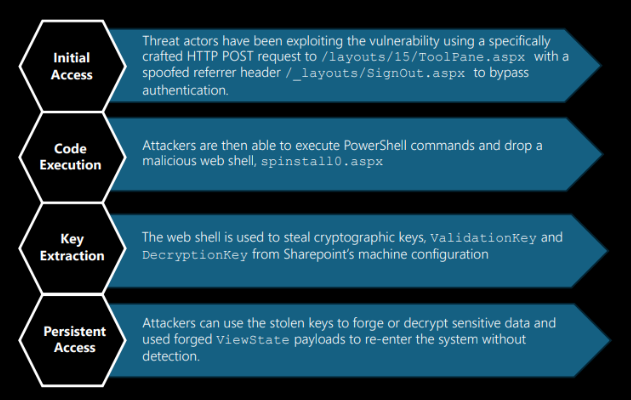TRACE | Cyber Advisory | Microsoft SharePoint Vulnerabilities Exploited

Cyber threat actors are actively exploiting vulnerabilities in on-premise versions of Microsoft SharePoint. Here, we provide advice for businesses on how best to protect themselves from this developing risk.
Edited by: Danny Howett, Technical Director – Digital Forensics and Incident Response.

What Has Happened?
Two critical SharePoint vulnerabilities have been under active exploitation since July 18, enabling attackers to upload malicious files and steal cryptographic secrets to aid them in maintaining persistence for future attacks.
CVE-2025-53770 is a critical unauthenticated remote code execution (RCE) vulnerability impacting on-premise versions of Microsoft SharePoint. CVE-2025-53771 is a path traversal vulnerability leading to server spoofing, which can trick SharePoint into performing unauthorized actions by bypassing path validation and may be used in tandem with CVE-2025-53770 to gain an initial foothold or enhance persistence.
The attacks stem from incomplete fixes from earlier SharePoint vulnerabilities, allowing attackers to exploit even previously patched systems. Reports from July 23 indicate that over 400 organizations show signs of compromise through exploitation, with a further 8-10,000 servers at risk. Over 200,000 SharePoint services globally could be vulnerable to the exploit.
Attackers are targeting high-value sectors including Government Agencies, Energy and Critical Infrastructure, Educational and Research organizations, Telecoms and Tech, but all businesses running unpatched affected versions should be considered at risk.
The Following Versions of SharePoint are Affected:
- SharePoint Server Subscription Licence - All builds prior to (KB5002768)
- SharePoint Server 2019 - Builds earlier than 16.0.10417.20027 (KB5002754)
- SharePoint Server 2016 - Builds earlier than 16.0.5513.1001 (KB5002759)
- Older SharePoint Server versions (2013 and prior) are no longer supported and remain vulnerable
Attack Methodology*

*IT security teams should search logs (IIS, Event) for anomalous ViewState payloads or unauthorized POST requests, scan file systems for newly added aspx files, validate machineKey integrity and use EDR/XDR tools to search for known IOCs or signatures.
What Should Organizations Do?*
- Update and patch affected systems immediately. Visit the Microsoft website for
the latest patches and information (ensure that you are visiting the genuine
Microsoft site, other threat actors' prey on significant cyber events, and often
spread malware through phishing or malvertising campaigns) - Rotate all cryptographic keys (ASP.NET, machinekey, certificates and secrets) after patching
- Review audit logs and hosts for malicious payloads or ViewState anomalies
- Invalidate all sessions and re-issue authentication tokens
- Segment and monitor SharePoint servers and look for signs of lateral movement
*This is not intended to be comprehensive remediation guidance, and organizations should follow the latest advice from official sources e.g. Microsoft.
Indicators of Compromise
Organizations should monitor for the known indicators of compromise associated with the vulnerability, and monitor for newly published IoCs.
SHA-1 File Hashes/Filenames
- f5b60a8ead96703080e73a1f79c3e70ff44df271 – spinstall0.aspx
- fe3a3042890c1f11361368aeb2cc12647a6fdae1 – xxx.aspx
- 76746b48a78a3828b64924f4aedca2e4c49b6735 –App_Web_spinstall0.aspx.9c9699a8.avz5nq6f.dll
IP Addresses (Known to be Actively Exploiting the Vulnerabilities)
- 96.9.125[.]147
- 107.191.58[.]76
- 104.238.159[.]149
- 139.59.11[.]66
- 154.223.19[.]106
- 103.151.172[.]92
- 45.191.66[.]77
- 83.136.182[.]237
- 162.248.74[.]92
- 38.54.106[.]11
- 206.166.251[.]228
- 45.77.155[.]170
- 64.176.50[.]109
- 149.28.17[.]188
- 173.239.247[.]32
- 109.105.193[.]76
- 2.56.190[.]139
- 141.164.60[.]10
- 124.56.42[.]7

We Can Help
Expand your threat intelligence monitoring capabilities beyond the dark web with support from CyXcel’s TRACE team. Contact our experts today to find out more.
Photo by Riccardo Persello on Unsplash.
